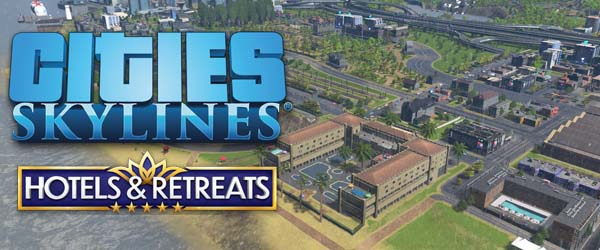
Surely this has to be the last DLC that Cities: Skylines is receiving, given that the sequel is due out this fall. This last wave of expansions and content creator packs has scratched a lot of very specific itches that I've had with Cities: Skylines for a long time, and they've had me playing the game a lot lately. I've been building a large city up over 100 thousand population, and also going back to some older save files and either upgrading them to use newer DLC assets, or to replace old mod assets with analogous official DLC assets.
A near seamless fit
What I really like about Hotels & Retreats is how seamlessly they fit into the existing game. Like with Industries, Campus, and Airports, I feel that Hotels & Retreats could easily have fallen into the trap of replacing old assets and rendering them moot or useless. Like, if the DLC had added a "resort area" mechanic using the Parklife area painting mechanic with modular hotels and resorts, it could easily have caused me to stop using the After Dark leisure and tourism district specializations (just like I've basically stopped using farm, forestry, oil, and ore industry specializations because I use the Industries areas instead).
Hotels & Retreats works very well alongside other expansion content!
Instead of feeling like a replacement for the existing tourism districts, the content of Hotels & Retreats is a great supplement. In fact, it feels like it could easily have been part of the After Dark expansion. Or the Parklife expansion. Or the Airports expansion. Or Plazas & Promenades. Or even the previous Financial Districts DLC.
Each hotel has preferences for proximity to a combination of city landmarks, shopping, offices, or nature. How well the hotel's location fits its unique combination of those 4 preferences will determine how popular it is for guests, which in turn will influence how much (if any) profit it makes, and the player can set its pricing accordingly. A business hotel placed in the middle of an IT or financial specialty district, along with some nearby commercial districts, will generate high profit; while a rental cabin will do best if placed in the vicinity of a nature preserve, in the middle of a forest, or along a pristine scenic coastline.
Each individual hotel's profit is aggregated into a total profit margin for the "chain" of hotels, and higher-level hotels are unlocked by increasing the weekly profit of the entire chain. So improperly-placed or poorly-performing hotels can be subsidized by the fully-occupied, perfectly-placed hotels with higher prices and profit margins.
Cheap, unprofitable niche hotels can be subsidized by the more popular and expensive hotels.
[More]
8424b6e9-a9f1-4b73-bdc8-0f5de5b5d48b|0|.0
Tags:Cities: Skylines, Cities: Skylines: Hotels and Retreats, hotel, resort, beach, park, tourism, roads, Cities: Skylines: Parklife, Cities: Skylines: Industries, Cities: Skylines: Natural Disasters
Last week, just in time for the announcement (and release) of a new expansion for Cities: Skylines, I posted a video analysis on YouTube discussing what I perceive as weaknesses in the modular design philosophy behind Skylines' myriad expansion packs. The full video is available on YouTube (and embedded below), but I've also transcribed the text in blog form for those who may prefer reading over watching/listening.
The video is up on YouTube.
I want to start out by saying that I love Cities: Skylines. Skylines is -- without a doubt in my mind -- the single best city-builder since SimCity 4, which released in 2003 (over 15 years ago, as of the time of this recording). When I watched the first trailer for the game, in which the player apparently custom-builds freeway ramps and interchanges from scratch (at about 40 seconds into the trailer), I was sold on this game! After years of having to use boring, pre-fabricated stock on-ramps and interchanges, the little civil engineer withing me practically jizzed in his pants at the idea of being able to build my own highway ramps and interchanges! And there was no looking back.
Cities: Skylines gloriously succeeds where games like SimCity (2013) and Cities XL miserably failed. It picks up the mantle of the great SimCity games of yester-decade, and brings it into the 21st century with deep simulation based on agents, a sleek and modern UI, extensive customizability and moddability, and an attractive 3-D graphics engine. It's made all the more impressive by the fact that the game's developer, Colossal Order, is a small, independent studio that had something like nine people working for it when the game initially launched. And a company with all the manpower and resources of Electronic Arts only managed to produce a flop like SimCity 2013.
... [More]
cdac9d28-8482-4449-a673-ff10d4b7cc87|0|.0
Tags:Cities: Skylines, Cities: Skylines: After Dark, Cities: Skylines: Snowfall, Cities: Skylines: Natural Disasters, Cities: Skylines: Mass Transit, Cities: Skylines: Green Cities, Cities: Skylines: Parklife, Cities: Skylines: Industries, Cities: Skylines: Campus, Colossal Order, city planner, city simulation, strategy, Steam, Paradox Interactive, expansion, YouTube, Sid Meier's Civilization, Civilization V, Civilization V: Brave New World, Civilization VI, Civilization VI: Rise and Fall, Civilization VI: Gathering Storm
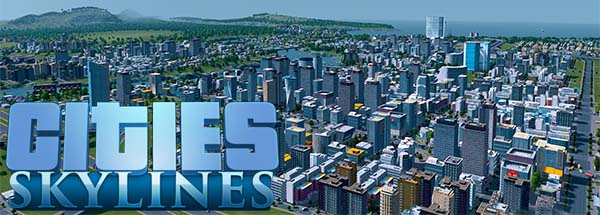
Some of the suggestions from my first wishlist have actually been implemented in Cities: Skylines. Naming roads, and adding directional traffic overlays were recently added in the Mass Transit expansion, and the previous Snowfall expansion incorporated some of my ideas for seasonal cycles (minus the part where the seasons actually cycle from one to another). There's still a lot of items from that wishlist that haven't been implemented. I also have come up with some new ideas for things I'd like to see in further expansions (or maybe a sequel?).
Taking the best ideas from its competitors
Even though Cities: Skylines is, by far, my favorite (and probably the objective best) city-building / city-simulation game of the past decade, there are still some features and ideas from the inferior games that I really like. In my first wishlist, I already talked about how much I liked the modular building mechanic of SimCity (2013).
I won't go into too much detail of why I liked that concept (even though the actual implementation was a little weak) because I invite you to read the original post. Suffice it to say, I liked the idea of certain pieces of city infrastructure (such as power plants, schools, universities, police stations, airports, government buildings, etc.) actually growing along with the city. Being able to upgrade an existing building to add additional functionality, additional capacity, or to specialize it in some way, was (in my opinion) a much more interesting and engaging process than simply plopping another copy of the same building every so often, or adjusting a global budget slider, simply to meet increasing demand.
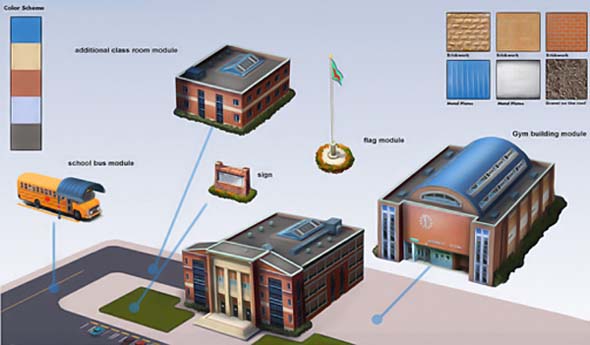
I still think SimCity had the right idea with its modular buildings.
In that first wishlist, I also briefly mentioned the Cities XL series. There isn't much in XL (or XXL) that is done as well (or better) than what is offered in either SimCity (2013) or Cities: Skylines, but I did neglect one idea that I think was probably the most clever, interesting, and fun part of the XL series of games: the ability to "fill" an area with "decoration". Put simply, Cities XL allows the player to fill any unoccupied area of the map (that is at least partially enclosed by roads) with one of several different types of decorative landscaping.
Landscaping options include a grassy park area with trees, an open-air "flea market" with kiosks and street vendors, various plazas / courtyards, and even a makeshift construction site. These decorations aren't functionally different (the flea market doesn't produce any commerce or jobs, for example), but each decorative area applies a very small environmental beautification effect that increases happiness and land value for adjacent homes or businesses.
Decorative areas in Cities XL allows you to fill-in irregular shapes with city-beautification projects.
From a more aesthetic standpoint, Cities XL's decorative areas allow the player to make very efficient use of space, to fill any empty dead space, and to create your own custom parks and plazas that conform to whatever shapes the outlining roads happen to be. Want a park in the middle of a large roundabout? Want a plaza space at the point of a 45-degree (or narrower) intersection? XL allows you to do such things without having to go into an asset-editor to make a custom ploppable.
Despite having muuuuuch better tools for creating curved and angled roads, Skylines doesn't really have any equivalent to these decorative features from XL that allow us to fill-in gaps left by our pretty, rounded or angled roads... [More]
61f9c85f-04f1-43df-ada3-cf727a4682d8|0|.0
Tags:Cities: Skylines, Cities: Skylines: After Dark, Cities: Skylines: Snowfall, Cities: Skylines: Natural Disasters, Cities: Skylines: Mass Transit, match day, Paradox Interactive, Colossal Order Ltd., PC, SimCity, CitiesXL, CitiesXXL, city simulation, park, decoration, parking, natural wonder, national park, beach, ski resort, tourism, leisure, history
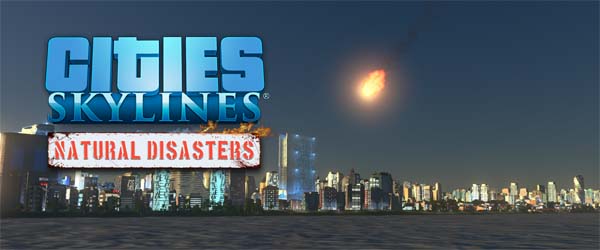
Cities: Skylines has always been a game that takes some different approaches to city builder gameplay. The base game explored how a city's geography can influence the development of the city, and also put a particular emphasis on designing efficient transit infrastructure by allowing the player incredible freedom to construct your own roads, highways, and interchanges, rather than relying on prefab ramps and over/under passes. None of these concepts were new to city builders, but Skylines added nuance to them and made them much more active elements of gameplay.
Its newest expansion DLC, Natural Disasters, follows suit. This is a very difficult expansion to review because its content - by its very nature - is random and unpredictable. Natural disasters aren't new to city builders. Disasters were a popular component of the old SimCity games, as many players enjoyed building up their beautiful metropolises only to unleash earthquakes, tornadoes, meteor impacts, and even alien invasions and dinosaur attacks and watch it all burn. Now Skylines has support for this fan-favorite SimCity feature, but it takes this commonplace feature in some new and interesting directions.
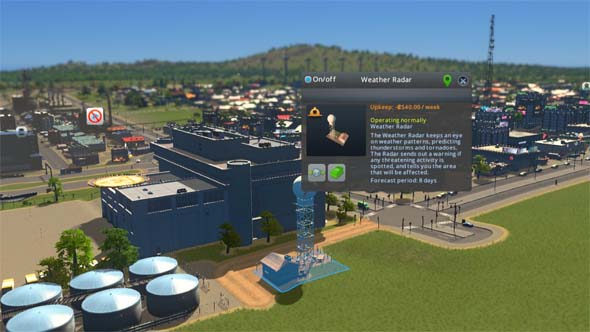
Installing early warning and detection systems will give you advance notice when a disaster is imminent.
Most notably, Cities: Skylines' take on disasters puts emphasis on preparation for disasters, rather than on the chaos of the disaster itself and the clean-up in its aftermath. Like with its SimCity forebears, disasters are something that you can toggle on or off in the game's menu, and you can also adjust their frequency. When enabled, you'll encounter disasters of various flavors ranging from forest fires to lightning strikes, to tsunami and meteor impacts. You'll have to make sure that your city is protected by preventative measures, and that it's protected against these eventualities.
Early-warning systems like firewatch towers, weather radar, and space telescopes can warn you about forest fires, storms or tornadoes, or even incoming meteors (respectively), and can mean the difference between your citizens having enough time to evacuate, or half your population being buried under rubble. You'll need evacuation shelters for you citizens to escape to, and each shelter needs to built long enough in advance for it to be stocked with supplies of food, water, and other essentials (which must be pulled from your city's economy or imported). And lastly, you'll need radio towers to warn your citizens to get to their designated shelters.
Building emergency shelters, stocking them with supplies, and planning evacuation routes will protect your citizens.
You can also create planned evacuation routes similar to bus routes that will pick up residents and take them to a shelter. I had some trouble getting these routes to work properly though. The fact that the buses are dispatched when an evacuation is activated means that they often create a log jam on your roads as they all funnel out of the shelter. I also had issues with the buses apparently not picking up people who were at more distant stops on the route, since the areas along the route that were far from the shelter never managed to evacuate. Maybe there's some trick to getting these routes to work properly that I just haven't found yet. But this does highlight one problem with the expansion: its new systems are not very well documented or explained... [More]
9ae61f59-31e1-483a-bb60-03cd1377e8b2|2|3.0
Tags:Cities: Skylines, Cities: Skylines: Natural Disasters, Colossal Order Ltd., Paradox Interactive, Steam, Steam Workshop, city simulation, DLC, expansion, disaster, natural disaster, emergency, evacuation, fire, earthquake, tornado, meteor, tsunami, flood
|

| 12 | | | | | | | 60 | | 11 | | | | | | | 55 | | 10 | | | | | | | 50 | | 09 | | | | | | | 45 | | 08 | | | | | | | 40 | | 07 | | | | | | | 35 | | 06 | | | | | | | 30 | | 05 | | | | | | | 25 | | 04 | | | | | | | 20 | | 03 | | | | | | | 15 | | 02 | | | | | | | 10 | | 01 | | | | | | | 05 |
|